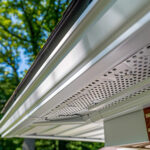When winter descends on Ohio, we aren’t the only ones seeking warmth and shelter. Wildlife like squirrels, raccoons, birds, and even bats often turn to rooftops and attics as cozy retreats from the cold. While these critters may look harmless, they can wreak havoc on your roof, gutters, and insulation, leading to costly repairs if left unchecked.
In this guide, we’ll explore common wildlife threats, the damage they can cause, and practical steps you can take to protect your home during Ohio’s chilly months.
Common Ohio Wildlife That Target Your Roof

Ohio’s wildlife is diverse, but during winter, a few usual suspects are known to cause problems for homeowners:
- Squirrels
Squirrels are notorious for chewing through shingles, soffits, and even wiring to gain entry into attics. Once inside, they can build nests, creating a fire hazard and structural damage. - Raccoons
These crafty animals can rip up shingles or fascia boards to access your roof. Raccoons often carry diseases and leave behind a mess of droppings and debris. - Birds
Starlings, pigeons, and other birds may nest in your gutters, blocking water flow and leading to ice dams. They can also bring mites and other pests into your home. - Bats
Though protected by law in many areas, bats can squeeze into tiny openings and roost in your attic, leaving behind guano that can cause health issues. - Mice and Rats
These small critters often use your roof as a gateway into your attic, where they can chew through insulation and wiring.
Did You Know? Wildlife Protection Laws for Bats in Ohio
While protecting your roof from wildlife is essential, it’s equally important to follow state regulations regarding protected species like bats. In Ohio, specific laws ensure the humane treatment of bats, especially during vulnerable periods such as breeding seasons.
Key Laws to Know About Bat Protection:
- It is illegal to:
- Use glue traps, chemicals, toxicants, or foggers to kill bats.
- Seal entry/exit points while bats are inside the structure.
- Intentionally kill bats unless human rabies exposure is suspected.
- Special Exclusion Periods:
From May 16th through July 31st, you’ll need written permission to perform bat exclusions, as this period is critical for bat breeding. During this time, property owners or their designees must:- Inspect the structure for bats.
- Conduct two bat watches (½ hour before to 1 hour after sunrise or ½ hour before to ½ hour after sunset within a seven-day period).
- If five or more bats are observed, additional watches aren’t required, but exclusion may still require Division authorization.
- If four or fewer bats are observed, exclusions can proceed without authorization.
- Exceptions: The Ohio Division of Wildlife may allow immediate exclusions if human health and safety are at risk or if nighttime temperatures exceed 40°F during restricted October dates.
Taking these regulations into account helps preserve Ohio’s bat populations while responsibly protecting your home. For more details, check out the Ohio Department of Natural Resources guide on nuisance bats.
How Wildlife Can Damage Your Roof
Even small animals can cause significant damage to your home’s exterior and interior. Here’s what to watch out for:
- Chewed or Torn Shingles: Squirrels and raccoons may rip through roofing materials to access attics.
- Clogged Gutters: Bird nests and debris can lead to water backup and ice dams, increasing the risk of leaks.
- Compromised Insulation: Animals nesting in your attic often destroy insulation, reducing your home’s energy efficiency.
- Structural Damage: Persistent scratching or gnawing can weaken wooden beams and roof supports.
- Health Hazards: Animal droppings can carry bacteria, parasites, and other pathogens harmful to humans.
Preventing Wildlife Damage
Winterizing your roof and taking preventative measures can keep critters at bay. Here’s how to protect your home:
- Inspect and Seal Entry Points
- Look for gaps around vents, chimneys, and soffits, as well as holes in roofing materials.
- Use metal flashing or heavy-duty mesh to seal vulnerable areas.
- Maintain Your Gutters
- Clean gutters regularly to prevent nesting and blockages.
- Install gutter guards to deter birds and squirrels.
- Trim Overhanging Branches
- Trees near your home provide easy access for climbing animals. Keep branches at least six feet from your roofline.
- Install Roof Vent Covers
- Protect vents and chimneys with sturdy covers that allow airflow but prevent animals from entering.
- Schedule Regular Roof Inspections
- A professional inspection can identify damage or weak spots that may invite wildlife.
What to Do If Wildlife Has Already Moved In
If you suspect animals have taken up residence in your roof or attic, follow these steps:
- Confirm Their Presence: Look for signs like droppings, scratching noises, or visible nests.
- Use Humane Removal Methods: Contact a licensed wildlife control expert for safe and humane removal.
- Repair Damage Promptly: Fix entry points and damage caused by the animals to prevent future problems.
- Avoid DIY Solutions: Attempting to trap or handle wildlife yourself can be dangerous and may violate local laws.
Keep Your Roof Wildlife-Free This Winter
Ohio’s wildlife may be charming, but their impact on your roof is anything but. By staying proactive and taking steps to protect your home, you can enjoy a cozy, critter-free winter. If you need help with roof inspections, repairs, or wildlife prevention, contact our team of experts today. Together, we’ll ensure your home stays secure no matter how cold it gets outside.









